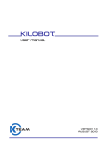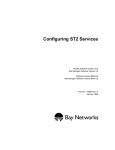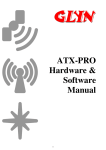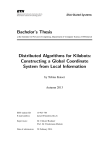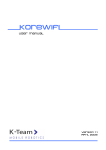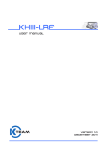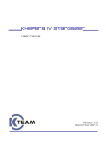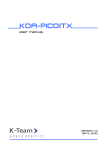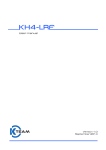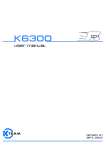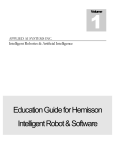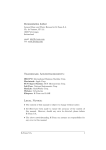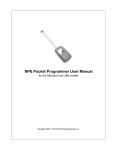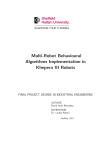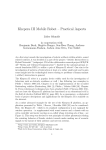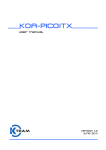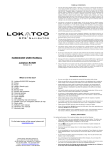Download Kilobot - K-Team
Transcript
Kilobot User manual Version 1.0 DECEMBER 2011 Documentation Author Julien Tharin K-Team S.A. Rue Galilée 9, Y-Parc 1400 Yverdon-les-Bains Switzerland Email: [email protected] Url: www.k-team.com Documentation version Version 1.0 Date 12.12.2011 Author J. Tharin Description First draft Trademark Acknowledgements: IBM PC Macintosh SUN Sparc-Station LabVIEW Matlab Webots Logitech Gumstix Khepera : : : : : : : : : International Business Machines Corp. Apple Corp. SUN Microsystems Corp. National Instruments Corp. MathWorks Corp. Cyberbotics Ltd Logitech Int. SA Gumstix Inc. K-Team SA LEGAL NOTICE: • • • The contents of this manual are subject to change without notice All efforts have been made to ensure the accuracy of the content of this manual. However, should any error be detected, please inform K-Team. The above notwithstanding, K-Team can assume no responsibility for any error in this manual. TABLE OF CONTENTS 1. INTRODUCTION..................................................................................................1 1.1 1.2 1.3 1.4 2. UNPACKING AND INSPECTION .....................................................................4 2.1 2.2 3. PACKAGE CONTENTS................................................................................................. 4 INSPECTION ............................................................................................................... 5 DESCRIPTION......................................................................................................6 3.1 3.2 4. HOW TO USE THIS HANDBOOK ................................................................................... 1 SAFETY PRECAUTIONS ............................................................................................... 2 RECYCLING ............................................................................................................... 2 SPECIFICATIONS ........................................................................................................ 3 OVERVIEW ................................................................................................................ 6 KILOBOT HARDWARE ................................................................................................ 7 USAGE....................................................................................................................8 4.1 REQUIRED HARDWARE / SOFTWARE ........................................................................... 8 4.1.1 REQUIRED HARDWARE: ..................................................................................... 8 4.1.2 REQUIRED SOFTWARE:....................................................................................... 8 4.2 CONNECTIONS ........................................................................................................... 9 4.3 POWER-UP............................................................................................................... 10 4.4 INSTALLATION ........................................................................................................ 11 4.4.1 OVERHEAD CONTROLLER (OHC) SOFTWARE INSTALLATION ........................... 11 4.4.2 OVERHEAD CONTROLLER (OHC) HARDWARE INSTALLATION ......................... 11 4.4.3 KILOBOT BOOTLOADER PROGRAMMING ........................................................... 12 4.5 USAGE .................................................................................................................... 14 4.5.1 PROGRAMMING A KILOBOT GROUP WITH A NEW PROGRAM ............................... 14 4.5.2 OHC USE ........................................................................................................ 15 4.5.3 KILOBOTS API ................................................................................................ 18 5. ANNEXES.............................................................................................................20 5.1 EXAMPLES CODE ..................................................................................................... 20 5.1.1 TRANSMITS DATA TO NEIGHBORS, AND BLINKS LED WHEN THE MESSAGE IS RECEIVED:....................................................................................................................... 20 5.1.2 NON-BLOCKING TIMED MOVEMENT: ................................................................ 20 5.1.3 RANDOM MOVE IN SEE NEIGHBORS, STOP ELSE ................................................. 22 6. WARRANTY........................................................................................................25 1. INTRODUCTION 1. INTRODUCTION Thank you for buying the Kilobot! Kilobots are low cost robots designed at Harvard University's Self-Organizing Systems Research Lab http://www.eecs.harvard.edu/ssr. The robots are designed to make testing collective algorithms on hundreds or thousands of robots accessible to robotics researchers. Though the Kilobots are low-cost, they maintain abilities similar to other collective robots. These abilities include differential drive locomotion, on-board computation power, neighbor-toneighbor communication, neighbor-to neighbor distance sensing, and ambient light sensing. Additionally they are designed to operate such that no robot requires any individual attention by a human operator. This makes controlling a group of Kilobots easy, whether there are 10 or 1000 in the group. 1.1 How to use this handbook This handbook introduces the Kilobot and its various operating modes. For a quick start, jump to chapter 4 ”Usage”. If this handbook does not answer one of the problems you wish to solve, please consult the K-Team web site (http://www.k-team.com) and especially the Forum and the FAQs. • Unpacking and Inspection : Kilobot package description and first use. • Description : Kilobot description. • Usage : Kilobot usage descriptions. • Annexes : Examples of source code. Kilobot User Manual 1 1. INTRODUCTION 1.2 Safety precautions Here are some recommendations on how to correctly use the Kilobot: 1.3 • Keep the board away from wet area. Contact with water could cause malfunction and/or breakdown. • Store your board in a stable position. This will avoid the risks of falling, which could break it or cause damage to a person. • Do not plug any connectors while the board is powered on. To avoid any damage, make all connections when the board power is off. Recycling Think about the end of life of your product! Parts of the board can be recycled and it is important to do so. By recycling you can help to create a cleaner and safer environment for generations to come. For those reasons please take care to the recycling of your product at the end of its life cycle, for instance sending back the product to the manufacturer or to your local dealer. Thanks for your contribution to a cleaner environment! 2 Kilobot User Manual 1. INTRODUCTION 1.4 Specifications The main specifications of the Kilobot robot are listed below: • Processor : ATmega 328 (8bit @ 8MHz) • Memory : ○ 32 KB Flash used for both user program and bootloader ○ 1KB EEPROM for storing calibration values and other non-volatile data and 2KB SRAM. • Battery : Rechargeable Li-Ion 3.7V, for a 3 months autonomy in sleep mode. Each Kilobot has a built-in charger, which charges the onboard battery when +6 volts is applied to any of the legs, and GND is applied to the charging tab. • Charging : Kilobot charger (optional) • Communication : Kilobots can communicate with neighbors up to 7 cm away by reflecting infrared (IR) light off the ground surface. • Sensing : ○ When receiving a message, distance to the transmitting Kilobot can be determined using received signal strength. ○ The brightness of the ambient light shining on a Kilobot can be detected. ○ A Kilobot can sense its own battery voltage. • Movement : Each Kilobot has 2 vibration motors, which are independently controllable, allowing for differential drive of the robot. Each motor can be set to 255 different power levels. • Light : Each Kilobot has a red/green/blue (RGB) LED pointed upward, and each color has 3 levels of brightness control. • Software : The Kilobot Controller software is available for controlling the controller board, sending program files to the robots and controlling them. • Programming : For programming, the open source development software WinAVR combined with AvrStudio from Amtel gives a C programming environment. An API with basic functions such as motor speed, led control, distance measurement,... is available and some examples are provided. • Debug : A serial output header is available on each robot for debugging via computer terminal. • Dimensions : The diameter is 33 mm and the height is 34mm (including the legs) Kilobot User Manual 3 2. UNPACKING AND INSPECTION 2. UNPACKING AND INSPECTION 2.1 Package Contents Figure 2-1: Contents of the Kilobot Pack Your package should contain the following items: 1. DVD-Rom with software 2. Kilobot robot 4 Kilobot User Manual 2. UNPACKING AND INSPECTION 2.2 Inspection To be continued… Kilobot User Manual 5 3. Description 3. Description 3.1 Overview An overview of the Kilobot hardware is depicted in the Figure 3-1. The locations of various key elements are indicated for later references. Figure 3-1: Kilobot overview ① 3.7-Volt Battery ⑦ Direct programming socket ② Power jumper ⑧ Charging Tab ③ Vibration motors ⑨ IR Transmitter ④ LED (Red/Green/Blue) ⑩ IR Receiver ⑤ Ambient light sensor ⑥ Serial output header 6 Kilobot User Manual 3. Description 3.2 Kilobot Hardware The hardware of the Kilobot is described in the sub-chapters thereafter. To be continued… Kilobot User Manual 7 4. Usage 4. Usage 4.1 Required hardware / software The required hardware and software to use the board and develop programs are described below. 4.1.1 Required hardware: • Computer with Microsoft Windows with USB port (not included) • Kilobot Robot • over-head controller (OHC) 4.1.2 Required software: Required files: 1. The compiler WINAVR from here: http://sourceforge.net/projects/winavr/files/WinAVR/20100110/. 2. The editor AVR Studio 4 found here (requires registration): http://www.atmel.com/forms/software_download.asp?category_id=163&family_id=607&s ubfamily_id=760&fn=dl_AvrStudio4Setup.exe 8 Kilobot User Manual 4. Usage 4.2 Connections To be continued… Kilobot User Manual 9 4. Usage 4.3 Power-up Kilobots should be operated on a smooth, flat, level surface to ensure proper robot mobility. To aid communication, the surface should be glossy or reflective. A dry-erase whiteboard oriented horizontally is recommended. To prevent communication interference, Kilobots should be operated in a location out of direct sunlight or other bright sources of Infra red light. The overhead controller should be hung above the Kilobots at a distance of about one meter. The robots beneath the OHC in a about a one meter diameter region will be able to receive messages from the OHC as shown below. 10 Kilobot User Manual 4. Usage 4.4 Installation The following sub-chapters explain the software installation and the application development with the board. 4.4.1 Overhead Controller (OHC) Software Installation 1. Place KilobotController folder in C: (so the location is C:\KilobotController) 2. Open KilobotController.exe 3. In the Help menu of KilobotController.exe, select “Installation and programming” and follow the instructions to install the software and drivers (Fig 4.4.1). Fig 4.4.1 OHC software 4.4.2 Overhead Controller (OHC) Hardware Installation 1. Connect both USB cables to the PC. 2. Toggle the OHC power switch to turn it on. 3. Run the KilobotController.exe program, and click the “Toggle LEDs” button to test that a connection is made (Fig 4.4.2). This should blink the blue LEDs on the controller. Kilobot User Manual 11 4. Usage Fig 4.4.2 OHC software buttons 4.4.3 Kilobot bootloader programming The Kilobot is delivered with a bootloader already installed. Therefore this step can be skipped. But If you would like to reinstall the bootloader or install a newer one, follow the instructions below. 1. Install WINAVR found here: http://sourceforge.net/projects/winavr/files/WinAVR/20100110/. 2. and also AVR Studio 4 found here (requires registration): http://www.atmel.com/forms/software_download.asp?category_id=163&family_id=607 &subfamily_id=760&fn=dl_AvrStudio4Setup.exe 3. In AVR Studio, select Tools->ProgramAVR->Autoconnect 4. In the window that pops up, under the program tab, in the flash category select the input hex file to be KilobotFirstFirmware.hex. 5. Turn on the robot by adding the power jumper as shown in figure 4.4.3. 12 Kilobot User Manual 4. Usage Figure 4.4.3 power jumper 6. Connect the AVRisp programmer to the robot as shown in figure 4.4.4. Make sure that the programmer pins do not touch the motor on the back side. Gently press the program cable to the side to ensure a good connection. Figure 4.4.4 communication connector 7. Set robot fuses: In Avr studio AVRISP programming window, go to the fuses tab. Select only the following fuses: spien, EESAVE, BOOTSZ (boot flash size 2048 word, start address =$3800) , SUT_CKSEL (int. RC Osc. 8 MHz; start-up time PWRDWN/RESET: 6 CK/14CK +65 ms). This should result in the following fuse values: extended=0xFF, high=0xD1, low=0xE2 Kilobot User Manual 13 4. Usage 8. In the Autoconnect pop-up window in AVRstudio press program. It should take a few seconds to program the robot, and the robot may vibrate. 4.5 Usage 4.5.1 Programming a kilobot group with a new program 1. In AVRstudio open the “Kilobot” project. 2. In UserProgramSkeleton.c locate the following section ///////////////////////////////////////////////////////////////////////////////////// //user program code goes here. this code needs to exit in a reasonable amount of time //so the special message controller can also run ///////////////////////////////////////////////////////////////////////////////////// 3. Immediately after this is where the user code is written. Some examples of the API are given in comments. Note that the user code should not contain long blocking functions; otherwise the robot may not respond to the overhead controller properly. 4. Once program is written, in AVRstudio select Build->build. 5. Run KilobotController.exe, click the button to browse for a program file as shown and select the program [.hex] file you just built (located at kilobot/default/UserProgramSkeleton.hex). Figure 4.5.1 Kilobot Controller software 6. Press the “Program Flash” button to program the OHC (a black window will pop up). 7. Place ALL Kilobot robot in PAUSE mode (LED flashing yellow) underneath the OHC, and press the “Bootload” button in KilobotController.exe. The Kilobot will first quickly flash red->green->blue, to indicate it is now in the PROGRAMMING mode. Within 5 seconds, the LED will begin to flash blue and continue flashing while it is receiving the 14 Kilobot User Manual 4. Usage new program. Once the LED has stopped flashing blue and switch to the flashing yellow of pause mode (approximately 30 seconds), press the “Stop” button in KilobotController.exe. 8. To run the program on the robot, press the “Run” button in KilobotController.exe. The new program should execute. 9. Press the “Pause” button in KilobotController.exe to stop the program. (Note: the robot needs to be in pause mode before programming can begin). You can find in annex 5.1 an example code. 4.5.2 OHC Use System Setup Kilobots should be operated on a smooth, flat surface to ensure proper robot mobility. To aid communication, the surface should be glossy or reflective. A mirror or dry-erase whiteboard oriented horizontally is recommended. The overhead controller should be hung above the Kilobots at a distance of about one meter. The robots beneath the OHC in a about a one meter diameter region will be able to receive communication from the OHC as shown in figure 4.5.2. Figure 4.5.2 System setup Kilobot User Manual 15 4. Usage Overhead Controller (OHC) Interface Overview Figure 4.5.3 Programming Panel 1. Program file: browse for the compiled Kilobot user program [.hex] file to be sent to the Kilobots. 2. Program Flash: send the program and controller files to the OHC. Figure 4.5.4 Connection Status You can see the OHC is connected to the pc or not (fig 4.5.4). Below in figure 4.5.5 is the Button Panel with a description of the buttons functionality. 16 Kilobot User Manual 4. Usage Figure 4.5.5 Button Panel 1. Bootload: transmit the kilobot user program from the OHC to the Kilobots, which takes about 30 seconds. Ensure all robots are in pause mode before bootloading. 2. Sleep: put Kilobots in low-power SLEEP mode. They will wake up briefly every 60 seconds to check if a wakeup message is being sent. The robots conserve energy in this mode and can stay in sleep for months without recharging. 3. Pause: put Kilobots in idle PAUSE mode, and is also used to prepares robots to be reprogrammed. 4. Run: initiates Kilobots user program. 5. Battery Voltage: instructs Kilobots to indicate their battery voltage through the LED. where green indicates a battery voltage over 4V, blue indicates a voltage between 3.75 and 4, yellow indicates a voltage between 3.5 and 3.75, and red indicates a voltage under 3.5 volts . 6. Bootloader msg: sends a message for all robots to exit their program and jump to the bootloader. 7. Wakeup: take Kilobots out of low-power SLEEP mode. This message will transmit untill stop is pressed. It will take a minute or two for all the robots to wake up. 8. Reset: restarts the Kilobot program. 9. Charge: instructs Kilobots to enter CHARGE mode for battery recharging. The robots will stop the user program and blink red if they are actively charging, if not, the RGB led will turn off. 10. Toggle LEDs: flashes the LEDs on the OHC. 11. Stop: stops whatever the OHC is doing. This can be used to stop functions that are continuous such as wakeup or bootloading. Kilobot User Manual 17 4. Usage 4.5.3 Kilobots API The different functions specialy developed for the Kilobot are explained below: • set_motor(cw_motor,ccw_motor) Set motor speed PWM values for motors between 0 (off) and 255 (full on) for cw_motor and ccw_motor Example: set_motor(100,100); note that there are 4 calibration values used with the motors cw_in_place - value for cw motor to turn the robot cw in place (note: ccw motor should be off) ccw_in_place - value for ccw motor to turn the robot ccw in place (note: cw motor should be off) cw_in_straight - value for the cw motor to move the robot in the forward direction ccw_in_straight - value for the ccw motor to move the robot in the forward direction • _delay_ms(x) Busy wait for x milliseconds, interrupts can still trigger //max value for milliseconds = 4000 Example: _delay_ms(250); • set_color(r,g,b) Set LED color, values can be from 0(off)-3(brightest) Example: set_color(1,1,1); • kprinti(int) Print integer over serial port - be careful can effect timing! Example: kprinti(12); • kprints(string) Print string up to 10 characters - be careful, can effect timing! Example: kprints("HelloWorld"); • message_out(tx0,tx1) Set message values to be sent over IR every .2 seconds, 2 bytes tx0,tx1 Example: message_out(0x01,0xFF); 18 Kilobot User Manual 4. Usage • get_message() Take oldest message off of rx buffer message. It is only new if message_rx[5]==1 ! If so, message is in message_rx[0] and message_rx[1]; distance to transmitting robot (in mm) is in message_rx[3] Example: get_message(); if(message_rx[5]==1) { data=message_rx[0]; distance=message_rx[3]; } • enable_tx to turn off the transmitter, set enable_tx = 0 to turn on the transmitter, set enable_tx = 1 Example: if(Want_To_Transmit==TRUE) enable_tx = 1; else enable_tx = 0; • measure_charge_status() Measure if battery is charging, returns 0 if no, 1 if yes Example: if(measure_charge_status()) charging = TRUE; else charging = FALSE; • measure_voltage() Measure battery voltage, returns voltage in .01 volt units for example if 394 is returned, then the voltage is 3.94 volts Example: current_voltage = measure_voltage(); • get_ambient_light() Returns the value of ambient light note: will return -1 if there is an incoming message (which also uses a/d) note: turns off interrupts for a short while to sample a/d Example: local_brightness = get_ambient_light(); Numerous other functions and AVR-C programming examples can be found on the web. Kilobot User Manual 19 5. Annexes 5. Annexes 5.1 Examples code These examples of code have different purposes described in there titles. 5.1.1 Transmits data to neighbors, and blinks led when the message is received: … message_out(255,255);//set message to be sent over IR enable_tx=1;//enable transmission of message every .2 seconds //check for message get_message(); if(message_rx[5]==1)//new message has been received { set_color(1,1,1);//turn RGB LED white kprinti(message_rx[0]);//send first byte of received message over serial debug cable kprinti(message_rx[1]);//send second byte of received message over serial debug cable kprinti(message_rx[3]);//send measured distance from transmitting robot over serial debug cable kprints(" "); _delay_ms(10);//wait 10 ms set_color(0,0,0);//turn RGB LED off } 5.1.2 Non-blocking timed movement: … static int mode=0;//mode represents state if(clock<40000) { //clockwise rotation if(mode!=0) 20 Kilobot User Manual 5. Annexes { set_motor(0,0xa0);//spin up cw motor to overcome friction _delay_ms(30); set_motor(0,cw_in_place);//set cw motor to calibrated value for good cw rotation mode=0; } } else if(clock<80000) { if(mode!=1) { //counter clockwise rotation set_motor(0xa0,0);//spin up ccw motor to overcome friction _delay_ms(30); set_motor(ccw_in_place,0);//set ccw motor to calibrated value for good cw rotation mode=1; } } else if(clock<120000) { if(mode!=2) { //move forward set_motor(0xa0,0xa0);//spin up both motors to overcome friction _delay_ms(30); set_motor(ccw_in_straight,cw_in_straight);//set both motor to calibrated value for good forward movement mode=2; } } else if(clock<160000) { if(mode!=3) { set_motor(0x00,0x00);//turn off motors mode=3; } } else if(clock<200000) { mode=5; clock=0;//reset clock to start cycle over agian } Kilobot User Manual 21 5. Annexes 5.1.3 Random move in see neighbors, stop else static int one_time=0; if(one_time==0)//if this is the start of the program, only run this if statement once { for(int i=0;i<30;i++) randseed+=measure_voltage( );//generate some random sensor data one_time=1;//indicate that the first time if statement has now run srand(randseed);//seed random variable with some sensor data } static int neighbor=0;//1 if i've seen any neighbors, 0 if not static int movement=0;//1 if moving, 0 if stopped static int start_move=0;//1 if the movement has changed, 0 if not //check to see if i have received any new messages, if so, then i have seen neighbors get_message(); if(message_rx[5]==1) neighbor=1; //if i am currently not moving, and want to start moving if(start_move==1) { if(movement==0) { set_motor(0xa0,0xa0);//spin up motors _delay_ms(30); set_motor(ccw_in_straight,cw_in_straight);//set to move straight } else if(movement==1) { set_motor(0xa0,0);//spin up motor _delay_ms(30); set_motor(ccw_in_place,0);//set to move ccw } else { set_motor(0,0xa0);//spin up motor _delay_ms(30); set_motor(0,cw_in_place);//set to move cw } start_move=2;//mark that i am currently moving } else if(start_move==0)//i do not want to move { set_motor(0,0); //stop motors } //every 2000 counts of clock, check to see if i've seen any neighbors //if i have, there is a 20% chance i will change my movement (such as straight to ccw) if(clock>2000) 22 Kilobot User Manual 5. Annexes { if((rand()%100)<20)//update robot movement 20% of the time { int rand_d=rand()%100; if(rand_d<25)//if updating robot movement 25% of the time move ccw { if(movement!=1) { movement=1; if(start_move==2) start_move=1; } } else if(rand_d<50)//if updating robot movement 25% of the time move cw { if(movement!=2) { movement=2; if(start_move==2) start_move=1; } } else//if updating robot movement 50% of the time move straight { if(movement!=0) { movement=0; if(start_move==2) start_move=1; } } } //if i've received a message from a neighbor in the last 2000 counts of clock //and i am not moving, start moving, and turn my rgb led red if(neighbor==1) { set_color(1,0,0); if(start_move==0) start_move=1; } else { //if i have not received a message from a neighbor in the last 2000 counts of clock //stop moving, and turn my RGB led off set_color(0,0,0); start_move=0; } Kilobot User Manual 23 5. Annexes clock=0;//reset clock neighbor=0;//reset neighbor count } 24 Kilobot User Manual 6. WARRANTY 6. WARRANTY K-TEAM warrants that the Korebot II is free from defects in materials and workmanship and in conformity with the respective specifications of the product for the minimal legal duration, respectively one year from the date of delivery. Upon discovery of a defect in materials, workmanship or failure to meet the specifications in the Product during the afore mentioned period, Customer must request help on K-Team Internet forum on http://www.k-team.com/forum/ by detailing: • the type of Korebot II used (version) • the kernel version of the Korebot II • the programming environment of the Korebot/robot (standard, version, OS) • the standard use of Product before the appearance of the problem • the description of the problem. If no answers have been received within two working days, Customer can contact KTEAM support by phone or by electronic mail with the full reference of its order and Korebot II serial number. K-TEAM shall then, at K-TEAM's sole discretion, either repair such Product or replace it with the equivalent product without charging any technical labor fee and repair parts cost to Customer, on the condition that Customer brings such Product to K-TEAM within the period mentioned before. In case of repair or replacement, K-TEAM may own all the parts removed from the defective Product. K-TEAM may use new and/or reconditioned parts made by various manufacturers in performing warranty repairs and replacement of the Product. Even if K-TEAM repairs or replaces the Product, its original warranty term is not extended. This limited warranty is invalid if the factory-applied serial number has been altered or removed from the Product. Kilobot User Manual 25 6. WARRANTY This limited warranty covers only the hardware and software components contained in the Product. It does not cover technical assistance for hardware or software usage and it does not cover any software products contained in the Product. K-TEAM excludes all warranties expressed or implied in respect of any additional software provided with Product and any such software is provided "AS IS" unless expressly provided for in any enclosed software limited warranty. Please refer to the End User License Agreements included with the Product for your rights with regard to the licensor or supplier of the software parts of the Product and the parties' respective obligations with respect to the software. This limited warranty is non-transferable. It is likely that the contents of Customer's flash memory will be lost or reformatted in the course of the service and K-TEAM will not be responsible for any damage to or loss of any programs, data or other information stored on any media or any part of the Product serviced hereunder or damage or loss arising from the Product not being available for use before, during or after the period of service provided or any indirect or consequential damages resulting therefore. IF DURING THE REPAIR OF THE PRODUCT THE CONTENTS OF THE FLASH MEMORY ARE ALTERED, DELETED, OR IN ANY WAY MODIFIED, K-TEAM IS NOT RESPONSIBLE WHATEVER. CUSTOMER'S PRODUCT WILL BE RETURNED TO CUSTOMER CONFIGURED AS ORIGINALLY PURCHASED (SUBJECT TO AVAILABILITY OF SOFTWARE). Be sure to remove all third parties' hardware, software, features, parts, options, alterations, and attachments not warranted by K-TEAM prior to Product service. K-TEAM is not responsible for any loss or damage to these items. This warranty is limited as set out herein and does not cover, any consumable items (such as batteries) supplied with the Product; any accessory products which is not contained in the Product; cosmetic damages; damage or loss to any software programs, data, or removable storage media; or damage due to (1) acts of God, accident, misuse, abuse, negligence, commercial use or modifications of the Product; (2) improper operation or maintenance of the Product; (3) connection to improper voltage supply; or (4) attempted repair by any party other than a K-TEAM authorized module service facility. This limited warranty does not apply when the malfunction results from the use of the Product in conjunction with any accessories, products or ancillary or peripheral equipment, or where it is determined by K-Team that there is no fault with the Product itself. 26 Kilobot User Manual 6. WARRANTY K-TEAM EXPRESSLY DISCLAIMS ALL OTHER WARRANTIES THAN STATED HEREINBEFORE, EXPRESSED OR IMPLIED, INCLUDING WITHOUT LIMITATION IMPLIED WARRANTIES OF MERCHANTABILITY AND FITNESS FOR A PARTICULAR PURPOSE TO THE FULLEST EXTENT PERMITTED BY LAW. Limitation of Liability: IN NO EVENT SHALL EITHER PARTY BE LIABLE TO THE OTHER FOR ANY INDIRECT, SPECIAL, INCIDENTAL OR CONSEQUENTIAL DAMAGES RESULTING FROM PERFORMANCE OR FAILURE TO PERFORM UNDER THE CONTRACT, OR FROM THE FURNISHING, PERFORMANCE OR USE OF ANY GOODS OR SERVICE SOLD OR PROVIDED PURSUANT HERETO, WHETHER DUE TO A BREACH OF CONTRACT, BREACH OF WARRANTY, NEGLIGENCE, OR OTHERWISE. SAVE THAT NOTHING HEREIN SHALL LIMIT EITHER PARTY'S LIABILITY FOR DEATH OR PERSONAL INJURY ARISING FROM ITS NEGLIGENCE, NEITHER PARTY SHALL HAVE ANY LIABILITY TO THE OTHER FOR INDIRECT OR PUNITIVE DAMAGES OR FOR ANY CLAIM BY ANY THIRD PARTY EXCEPT AS EXPRESSLY PROVIDED HEREIN. Kilobot User Manual 27 K-Team S.A. Rue Galilee 9 1400 Yverdon-les-Bains Switzerland

































